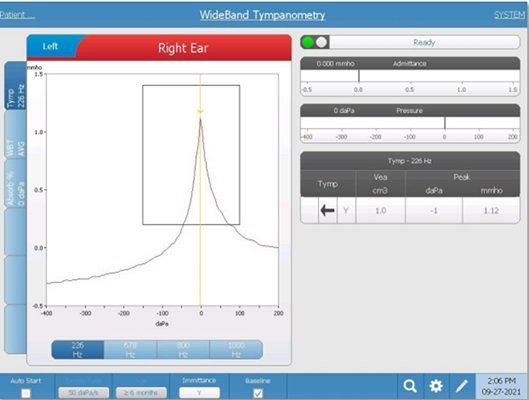WideBand Tympanometry
Tympanometry Guides
WideBand Tympanometry is a specialized test designed to evaluate middle ear function across a wide frequency range by utilizing a wideband click stimulus. Unlike traditional tympanometry, WideBand Tympanometry allows for obtaining tympanograms at multiple frequencies with a single pressure sweep. This innovation utilizes an automatic sequence of measurements to provide a complete dataset of the middle ear’s status, all while following the same testing procedure as traditional tympanometry. WideBand Tympanometry is available on the GSI TympStar Pro™ with the advanced license.

Probe Stimulus
WideBand measurements are obtained using a wideband click or “probe tone” that contains frequencies of 250 to 8000 Hz, as opposed to traditional single frequency probe tones such as 226 or 1000 Hz. Utilizing a wideband stimulus provides middle ear absorbance across the frequency range similar to an audiogram.
Test Instructions
“This test will help determine the middle ear function. I am going to place the probe into your ear canal. You will hear a clicking sound and feel pressure change. The test only takes a few seconds and all that is required of you is to remain still and to sit quietly.”
Test Procedure
1. On the TympStar Pro, press the MORE button and select WideBand Tympanometry to launch the test.
2. Select the desired sweep rate: 50 or 200 daPa/sec.
3. Select the appropriate age: greater than or equal to 6 months (adult) or under 6 months of age (infant.)
4. Select an appropriately sized eartip and place onto the probe.
5. Insert the probe into the patient’s ear canal, noting that deeper insertion ensures the most accurate absorbance measures.
6. Start the test. The test presents the Wideband click during a pressure sweep of +200 to -400 daPa.
7. Once completed, the TympStar Pro calculates and displays three tabs of test data:
- Traditional single frequency tympanograms at 226 Hz, 678, 800, and 1000 Hz
- WideBand Average Tympanogram
- Middle Ear Absorbance across the frequency range
Interpreting Results
The test results include an absorbance graph, which illustrates how much sound is absorbed by the middle ear from low to high frequency. The absorbance pattern in an ear with normal middle ear function differs considerably from ears with middle ear pathology. Notably, examples of absorbance tracings for common middle ear pathologies such as otosclerosis, middle ear effusion, and discontinuity of the ossicular chain are provided and can assist in test interpretation.
Sources
https://www.audiologyonline.com/files/event/37600/37617/transcript-cont-gsi-37356-widebandtympanometry.pdf
What is WideBand Tympanometry? (audiologyonline.com)
https://www.grason-stadler.com/wideband-tympanometry